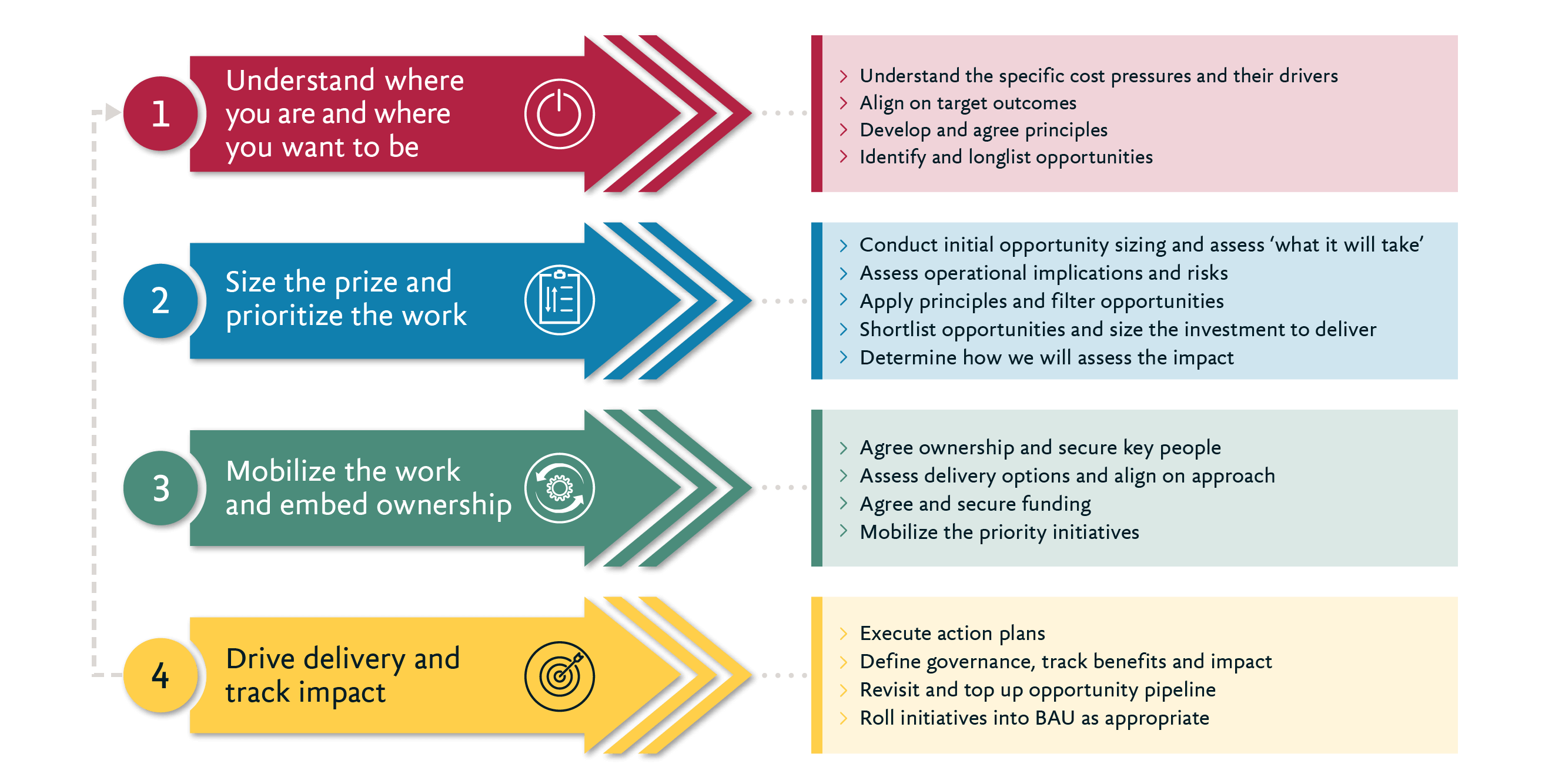Many businesses are seeking to achieve cost savings in response to increasingly challenging market and operating conditions. While you may have assessed your circumstances and decided to address your cost base, identifying and embarking on concrete actions can feel like a daunting prospect.
We recommend four key steps to address your cost challenge effectively and sustainably.
Four key steps for effective and sustainable cost optimization

1. Understand where you are and where you want to be
It will firstly be key to understand the drivers of cost pressure and the nature of the outcomes you want to achieve. Developing a set of key principles will help drive alignment on scope and priorities early on. This stage will conclude with identifying and longlisting opportunities including a combination of cost avoidance, cost reduction and cost optimization.
Key considerations for this stage include:
- Over what timeframe do you need to reduce cost? In-year or ongoing?
- Can you engage accountable budget holders early and instil a sense of ownership?
- Can you communicate the rationale to your people in a way that will drive the right behaviors?
- Where can you be open and transparent, and where do you need to be more cautious?
2. Size the prize and prioritize the work
This step begins with an initial assessment of your longlisted opportunities. You’ll initially want to understand the scale of savings that can be achieved, and what effort and investment may be required to achieve them. At this stage, an informed top-down assessment of both benefit and effort can be a quick and effective mechanism for initial prioritization and filtering of the long-list.
You will then assess the operational implications and risks. This may help you to prioritize further, as well as helping you to start to think about what you’ll require to have in place to realise the savings.
Begin thinking about measurement and metrics at this stage. Determine how you will assess whether, and to what extent, the initiatives have delivered on your target outcomes. It is important to include milestone assessments along the journey to gauge whether you need to adapt your plan, or add more opportunities to the hopper.
Key considerations for this stage include:
- How much depth do youI need to assess the size of the prize and the nature of the effort required to realize the saving?
- Do you have your eyes open for what each initiative will and won’t deliver, e.g. near-term in-year savings vs. ongoing reduction in the cost base?
- Do you need to ‘spend to save’? If so, what support will you need to secure the initial investment?
- How can you ensure accountable individuals have ‘skin in the game’, securing their buy-in and ongoing commitment?
- How can you free up scarce resources (both people and money) to set up for success?
3. Mobilise the work and embed ownership
Focus on building ownership and accountability for generating the cost outcome that you are targeting. Balance the imperative to get runs on the board early, while securing the support and resource required to drive longer-lead time elements.
Key considerations for this stage include:
- Where can you build traction and credibility quickly? What are the ‘just do it’ elements and what requires more time and thought?
- Do you understand the impact on customers and employees?
- Which opportunities are pyrrhic victories and how do you avoid these?
- Do your assessment criteria align with the needs and values of the business and the outcomes you are targeting?
- Do you have the right balance between tactical and structural initiatives?
4. Drive delivery and track impact
The rubber meets the road when you come to execute your action plans. It’s valuable to put some light-touch governance in place to track benefits and impacts, and to acknowledge wins.
Many cost optimization initiatives can be delivered through BAU, but some will require more of a programmatic approach. It is important to maintain a degree of joined-up governance and tracking across both to retain the focus on the overall cost outcome you have targeted and to avoid disruptive zero-sum behaviors and backsliding.
Cost optimization: a circular process
While we’ve highlighted four key steps, we recommend a circular and iterative approach. An ‘always on’ process of identification and dynamic prioritization will help you respond to ongoing and potential cost pressure in a considered, effective and sustainable manner.









